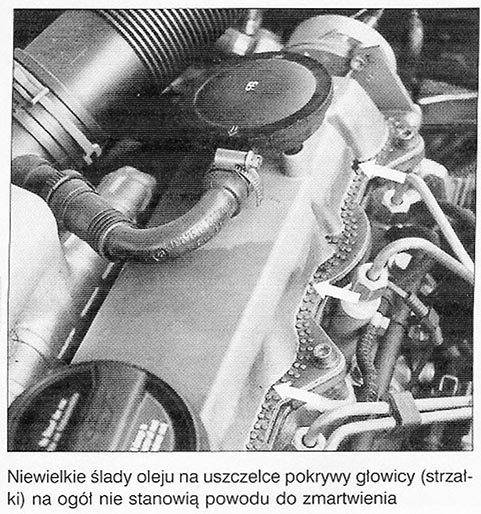Checking the tightness of the lubrication system.
The slight traces of oil on the engine are not yet a cause for concern. At high temperatures, oil can penetrate the pores in seals and housings. This kind of oil leakage is normal.
However, when you notice large splashes of oil in the engine compartment or under a parked car, then it is necessary to find out the reasons. A leak in the engine is a symptom of a technical fault, which may worsen rapidly. It is best to wash the engine thoroughly and check it carefully after a short drive.
Next steps:
1. Remove the upper engine cowl (description of activities in the previous chapter).
2. Remove the noise suppression cover (description of activities in the previous chapter).
3. Check the following places: the gasket of the oil filler cap, the crankcase breather hose (between the valve cover and the air intake pipe), heads gasket, oil drain plug, oil filter, oil pan gasket, Simmer rings on the crankshaft and camshaft.

Slight traces of oil on the cylinder head cover gasket (arrows) generally not a cause for concern.
Table. Problems in the engine lubrication system.
| Symptom of ailment | The reasons | Remedies |
| A. When the ignition is turned on, the oil pressure indicator lamp does not come on | 1.Indicator bulb defective | Replace the bulb |
| 2.Indicator contacts corroded or broken wire | Check and clean the contacts, possibly repair the cable | |
| 3.Defective overflow valve | Check, replace the valve if necessary | |
| B. When a warm engine is started, the oil pressure light is at idle and turns off after adding gas | Hot and therefore thin oil | |
| C. The oil pressure indicator light only goes out at a higher engine speed | Jamming valve in a circulation channel | Check the oil pressure, replace the valve if necessary |
| D. The oil pressure light comes on when the engine is started and does not go out after adding gas | 1.Too little oil in the engine | Check the oil level and refill |
| 2.Clogged pump strainer or damaged oil pump | Check the strainer, replace pump if necessary | |
| 3.See A2 and A3 | ■ If you agree, that these are the real causes, you can continue driving. After it is finished, remove these causes |
